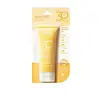What's inside
What's inside
 Key Ingredients
Key Ingredients

 Benefits
Benefits

 Concerns
Concerns

 Ingredients Side-by-side
Ingredients Side-by-side

Water
Skin ConditioningEthylhexyl Methoxycinnamate
UV AbsorberPropylene Glycol
Humectant4-Methylbenzylidene Camphor
UV AbsorberAcrylates Copolymer
Polyacrylamide
Butyl Methoxydibenzoylmethane
UV AbsorberDimethicone
EmollientPanthenol
Skin ConditioningCyclopentasiloxane
EmollientTriethanolamine
BufferingPhenoxyethanol
PreservativeC13-14 Isoparaffin
EmollientAloe Barbadensis Leaf Extract
EmollientLaureth-7
EmulsifyingDimethicone Crosspolymer
Emulsion StabilisingCarbomer
Emulsion StabilisingTocopheryl Acetate
AntioxidantDisodium EDTA
Triethylene Glycol
MaskingDimethicone/Vinyl Dimethicone Crosspolymer
Skin ConditioningDimethiconol
EmollientPotassium Sorbate
PreservativeSodium Benzoate
MaskingWater, Ethylhexyl Methoxycinnamate, Propylene Glycol, 4-Methylbenzylidene Camphor, Acrylates Copolymer, Polyacrylamide, Butyl Methoxydibenzoylmethane, Dimethicone, Panthenol, Cyclopentasiloxane, Triethanolamine, Phenoxyethanol, C13-14 Isoparaffin, Aloe Barbadensis Leaf Extract, Laureth-7, Dimethicone Crosspolymer, Carbomer, Tocopheryl Acetate, Disodium EDTA, Triethylene Glycol, Dimethicone/Vinyl Dimethicone Crosspolymer, Dimethiconol, Potassium Sorbate, Sodium Benzoate
Water
Skin ConditioningEthylhexyl Methoxycinnamate
UV AbsorberOctocrylene
UV AbsorberStyrene/Acrylates Copolymer
Cyclopentasiloxane
EmollientGlycerin
HumectantHexylene Glycol
EmulsifyingPolyacrylamide
PEG/PPG-20/6 Dimethicone
EmulsifyingZinc Oxide
Cosmetic ColorantC13-14 Isoparaffin
EmollientPolypodium Leucotomos Leaf Extract
Skin ProtectingPhenoxyethanol
PreservativeTitanium Dioxide
Cosmetic ColorantLaureth-7
EmulsifyingCetyl Dimethicone
EmollientCamellia Sinensis Extract
AntioxidantTocopheryl Acetate
AntioxidantDichlorobenzyl Alcohol
AntimicrobialMicrococcus Lysate
Skin ConditioningTetrasodium EDTA
Alumina
AbrasiveBHT
AntioxidantSimethicone
EmollientTriethoxycaprylylsilane
Parfum
MaskingLinalool
PerfumingLimonene
PerfumingWater, Ethylhexyl Methoxycinnamate, Octocrylene, Styrene/Acrylates Copolymer, Cyclopentasiloxane, Glycerin, Hexylene Glycol, Polyacrylamide, PEG/PPG-20/6 Dimethicone, Zinc Oxide, C13-14 Isoparaffin, Polypodium Leucotomos Leaf Extract, Phenoxyethanol, Titanium Dioxide, Laureth-7, Cetyl Dimethicone, Camellia Sinensis Extract, Tocopheryl Acetate, Dichlorobenzyl Alcohol, Micrococcus Lysate, Tetrasodium EDTA, Alumina, BHT, Simethicone, Triethoxycaprylylsilane, Parfum, Linalool, Limonene
 Reviews
Reviews

Ingredients Explained
These ingredients are found in both products.
Ingredients higher up in an ingredient list are typically present in a larger amount.
This ingredient is also known as "C13-14 Isoalkane".
C13-14 Isoparaffin is created from petroleum-based mineral oils. It is an emollient and helps thicken a product.
As an emollient, it helps keep the skin soft and smooth by creating a barrier on top. This barrier traps moisture in, keeping the skin hydrated.
C13-14 Isoparaffin may not be fungal-acne safe.
Learn more about C13-14 IsoparaffinCyclopentasiloxane, or D5, is a silicone used to improve texture of products and trap moisture.
D5 is considered lightweight and volatile. Volatile means it evaporates quickly after application. Once evaporated, D5 leaves a thin barrier that helps keep skin hydrated.
It is also an emollient. Emollients help soften the skin and prevent water loss. Silicones create a silky texture in products. D5 helps other ingredients become more spreadable.
Studies show D5 is safe to use in skincare products. We recommend speaking with a skincare professional if you have concerns.
Learn more about CyclopentasiloxaneEthylhexyl Methoxycinnamate is an organic compound that provides UVB protection. It often goes by the more common name of octinoxate. It is created from methoxycinnamic acid and 2-ethylhexanol.
Ethylhexyl Methoxycinnamate absorbs UVB rays with wavelengths between 280-320 nm. UV absorbers protect your skin by using chemical reactions to convert UV rays into heat and energy.
UVB (290-320 nm) rays emit more energy than UVA rays. They are capable of damaging DNA, causing sunburns and are thought to be linked to skin cancer.
The state of Hawaii has banned sunscreens containing octinoxate due to its potential impact on coral reefs. More research is needed to bridge gaps in this research. The European Union allows higher levels of octinoxate in sunscreens than the US and Australia.
Ethylhexyl Methoxycinnamate is oil soluble. It is not stable and may lose efficacy when exposed to sunlight.
Learn more about Ethylhexyl MethoxycinnamateLaureth-7 is created by the ethoxylation of lauryl alcohol using ethylene oxide. Lauryl alcohol is a fatty alcohol with hydrating properties.
This ingredient is an emulsifier and cleansing ingredient. As an emulsifier, it is used to prevent ingredients from separating. It also helps cleanse the skin by gathering dirt, oil, and pollutants to be rinsed away.
Phenoxyethanol is a preservative that has germicide, antimicrobial, and aromatic properties. Studies show that phenoxyethanol can prevent microbial growth. By itself, it has a scent that is similar to that of a rose.
It's often used in formulations along with Caprylyl Glycol to preserve the shelf life of products.
Polyacrylamide is a synthetic polymer. It is used to stabilize products and bind ingredients. When hydrated, Polyacrylamide forms a soft gel.
Polyacrylamide is low-toxicity. If source properly, it is deemed safe to use in cosmetics.
It should be noted the precursor to Polyacrylamide is acrylamide. Acrylamide is a carcinogen. Most reputable sources of Polyacrylamide will screen for residual acrylamide to make sure the count is in a safe range. Acrylamide is not able to be absorbed through the skin.
We recommend speaking with a professional if you have concerns.
Learn more about PolyacrylamideTocopheryl Acetate is AKA Vitamin E. It is an antioxidant and protects your skin from free radicals. Free radicals damage the skin by breaking down collagen.
One study found using Tocopheryl Acetate with Vitamin C decreased the number of sunburned cells.
Tocopheryl Acetate is commonly found in both skincare and dietary supplements.
Learn more about Tocopheryl AcetateWater. It's the most common cosmetic ingredient of all. You'll usually see it at the top of ingredient lists, meaning that it makes up the largest part of the product.
So why is it so popular? Water most often acts as a solvent - this means that it helps dissolve other ingredients into the formulation.
You'll also recognize water as that liquid we all need to stay alive. If you see this, drink a glass of water. Stay hydrated!
Learn more about Water